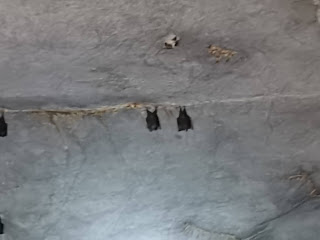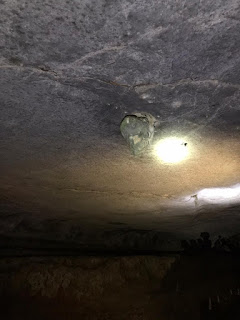Field trip to Bau
Tuesday, March 10, 2020
Bau is located about 34.2 km from Kuching City. It is known as the gold mining town in Kuching district. In 1857, there was a revolt by irate and persecuted gold miners against the White Rajah. As the rebellion raged on, the White Rajah’s forces pursued the rebels who ended up retreating into a cave. The soldiers lit a huge fire at the cave entrance to lure the rebels out but instead, it resulted in the rebels were burnt by fire or suffocated to death. The cave is now known as Ghost Cave, and the area became known as ‘Bau' which means ‘smelly’ in Malay because of the rather unpleasant smell that would come from such a tragic event.
During our field survey to Bau, we visited Blue Lake and Wind Cave. Both of this places have different types of ecosystem. First, we went to Blue Lake. It is man-made lake which result from the gold mining activities back then. It was called Blue Lake as the water reflects the sky color. The blue lake has a sharp, deep edge. However, the water from Blue Lake is not safe for human as it has high levels of arsenic due to long period of gold mining. The arsenic compounds occur naturally due to exposure and this minerals still stands at the lakeside. Therefore, as precautions, the government put warning signboard that warn the public not to swim, fishing or consume the water from the lake.
From my observation, the Blue Lake has mixed dipterocarp forests. Therefore, many biotic and abiotic factors were involved. I can say all abiotic factors are involved here but I want to highlight the crucial factors that help the species in this habitat can survive, which are:
Next, we went to Wind Cave which located 2.2 km from Blue Lake. Wind Cave spans about 6 hectares and has been gazetted as a nature reserve. It is a smooth limestone cave and was formed roughly 60 million years ago. Wind Cave also surrounded with mixed dipterocarp forest and freshwater streams. It is also home for swiftlets, bats and more animals. When entering the cave, we can see many stalagmites and stalactites that are million of years old and this cave is equipped with plank walk for easy exploration. There are many plants and animals in this limestone area. Each fulfill their needs with their own ways. It can be said that there are interspecific reaction occur here. All abiotic factors play important roles here, especially light, water, soil, wind, atmospheric gases and physiographic.
From my observation, the Blue Lake has mixed dipterocarp forests. Therefore, many biotic and abiotic factors were involved. I can say all abiotic factors are involved here but I want to highlight the crucial factors that help the species in this habitat can survive, which are:
- Light
- Soil
- Physiographic
- Temperature
Figure 1.1
Figure 1.2
Figure 1.3
Figure 1.1 and Figure 1.2 show the ecosystem available in Blue Lake while Figure 1.3 shows the the sharp, deep edge of the Blue Lake
Figure 2.1
Figure 2.2
Figure 2.3
Figure 2.4
Figure 2.5
Figure 2.6
Figure 2.7
Figure 2.8
Figure 2.9
Figure 2.3 shows plants with stranglers growth form. Figure 2.5 shows the competition between different species to get light
Figure 2.2 show competition relationship while Figure 2.4 shows parasitism relationship and Figure 2.6 shows commensalism relationship
Figure 2.7, Figure 2.8 and Figure 2.9 show the way organism adapt themselves to the surrounding
In conclusion, this field trip is very useful as it helps students to understand more about the ecosystem. Therefore, there are many types of ecosystem in Bau, Sarawak, for instance, freshwater ecosystem and terrestrial ecosystem. Both of this ecosystem depends on both biotic and abiotic factors to continue their lives. These treasures need to be protected so that we can ensure the well-being of the environment.

























































